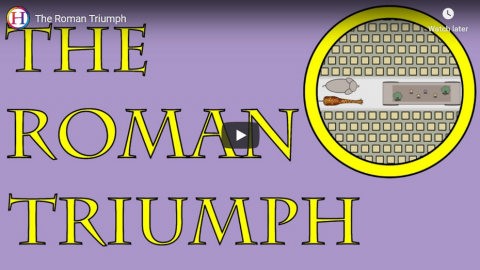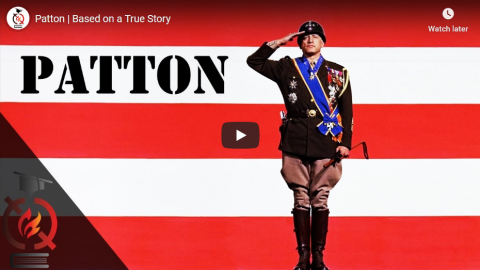Historia Civilis
Published 5 Dec 2018Patreon | http://patreon.com/HistoriaCivilis
Donate | http://www.paypal.com/cgi-bin/webscr?…
Merch | http://teespring.com/stores/historiac…
Twitter | http://twitter.com/HistoriaCivilis
Website | http://historiacivilis.comSources:
The Jewish War, by Josephus: https://amzn.to/2Ub8JRq
Parallel Lives: The Life of Pompey, by Plutarch: https://amzn.to/2BP6vjq
Parallel Lives: The Life of Julius Caesar, by Plutarch: https://amzn.to/2BP6vjq
Letters to Atticus, Book 13, by Cicero: https://amzn.to/2Qa9SKv
The History of Rome, Book 1, by Livy: https://amzn.to/2PbCkX7
Natural History, Book 3, by Pliny the Elder: https://amzn.to/2PhX3Za
Roman History, Book 43, by Cassius Dio: https://amzn.to/2PgJ99C
Roman History, Book 44, by Cassius Dio: https://amzn.to/2PgJ99C
Roman History, Book 53, by Cassius Dio: https://amzn.to/2Pgdq8Q
Roman History, Book 54, by Cassius Dio: https://amzn.to/2Pgdq8Q
Roman History, Book 55, by Cassius Dio: https://amzn.to/2Pgdq8Q
The Life of Julius Caesar, by Suetonius: https://amzn.to/2QuwULE
The Fasti Triumphales http://www.attalus.org/translate/fast…
The Roman Triumph, by Mary Beard: https://amzn.to/2UafiDD
Rubicon, by Tom Holland: https://amzn.to/2E0x5HX
Cicero, by Anthony Everitt: https://amzn.to/2PgJJnO
Julius Caesar, by Philip Freeman: https://amzn.to/2DXortC
Caesar: Life of a Colossus, by Adrian Goldsworthy: https://amzn.to/2Q9rtlO
The Rise of Rome, by Anthony Everitt: https://amzn.to/2PeSEGw
“Circum Metas Fertur: An Alternative Reading of the Triumphal Route,” by Ida Östenberg. From Historia: Zeitschrift für Alte Geschichte, vol. 59, no. 3: https://bit.ly/2SpsjHJMusic:
“Honey,” by Nctrnm
“XY,” by Nctrnm
“The House Glows (With Almost No Help),” by Chris Zabriskie
“Hallon,” by Christian BjoerklundWe are a participant in the Amazon Services LLC Associates Program, an affiliate advertising program designed to provide a means for us to earn fees by linking to Amazon.com and affiliated sites.
January 29, 2020
The Roman Triumph
Charles Stross on “reality” TV
I don’t watch much TV at all … after catching the Superbowl on Sunday, I may not turn on the TV until the NFL preseason gets underway in the summer, so my impressions of reality TV offerings are gathered second- or third-hand at best. That said, I do recall watching some very early reality TV in the late 80s or early 90s (the one that comes to mind was something like “take a bunch of urban Brits and dump them in a recreated iron age village”). As Charles Stross describes the current crop of shows, I’m very confident that I’ve missed absolutely nothing over the decades:
I watch as little television as I can, and most of it by accident.
Whenever I do catch an eyeful, it usually consists of one of three things: a talking heads news channel, organized sportsball, or a Reality TV show. The first I try to ignore (they’re usually triangulated on the tabloid newspapers with added eye candy, then dumbed down: as information sources this century, TV news channels are useless). The sportsball I leave to my spouse (who is prone to lecturing me interminably about Manchester City). But the latter phenomenon — Reality TV — has all the grisly attention-grabbing potential of a flaming school bus careening out of control into a public execution: I basically have to leave the room in a hurry to avoid having my eyeballs sucked right out of my head by the visual media equivalent of internet clickbait.
What makes Reality TV shows so addictive?
The sector is dominated by a couple of competing recipes. As in so many mature markets, there’s an 80/20 split between a dominant incumbent and an insurgent that isn’t quite successful enough to overturn a monopoly but is too tenacious to die. Think Android/iPhone, or car/pick-up truck (that latter died about a decade ago in the US).
In the case of rTV shows, the 20% insurgent is about people demonstrating competence. Mythbusters was the classic competence-porn show (although it deteriorated into the explosion-of-the-week club after a few seasons): using science!!! and workshop/lab work to evaluate the plausibility of urban legends. Other competence rTV shows include: a team of dudes acquire a car wreck and restore it to good-as-new condition, a former special forces soldier/scout troop leader is dumped on a desert island and demonstrates survival skills, and so on.
But the other 80% of rTV shows are incompetence porn.
Incompetence porn Reality TV, as pioneered by Big Brother, usually aims to get the audience to laugh at or mock the participants in a contest designed to plumb the depths of humiliation. Instead of dropping a fit expedition leader on a desert island, the show dumps a bunch of washed-up B-list celebs in a wilderness of mosquitos and no soft toilet paper. Or perhaps it’s a bunch of Armani-suited sociopaths in a boardroom where they’re expected to pitch business start-up proposals at a washed-up B-list business celeb like Alan Sugar (or, in the American version of The Apprentice, a certain mobbed-up New York property speculator with shady Russian banking connections). Back-stabbing is a given in the celebrity/sociopath driven variant of rTV, as incompetent contestants are shoved out of the show at every episode until only the most obliviously egocentric remains.
(Note that the survivor selection criterion isn’t “competence”, be it at wilderness survival or boardroom brown-nosing: it’s entertainment value. Because these shows, despite the name, aren’t about reality, they’re showbiz.)
But these aren’t the worst.
Patton | Based on a True Story
The Cynical Historian
Published 30 Aug 2018It’s finally time to review Patton! I have a lot to say about it, as you can tell by the time stamp. Way back when I started the Based on a True Story series, the second episode was a bit about what I considered to be the best ones — and this movie was at the top. I love this film, but for more reasons than most of you could know — so this is going to be a deep dive into the film and its subject matter. It’s ambiguous, narrowed in subject, and just a perfect examination of the man. As the New Yorker said during the movie’s release, “[Patton] appears to be deliberately planned as a Rorschach test.”
————————————————————
references:
Brian Sobel and George S. Patton IV, The Fighting Pattons (Westport: Praeger Publishing, 1997). https://amzn.to/2u2WI57MacMillan Compendium, America at War (New York: Macmillan Library Reference, 1994), 726-727. https://amzn.to/2m6o4mx
John Keegan and Andrew Wheatcroft, Who’s Who in Military History: from 1453 to the Present Day, (London: Routledge, 1996), 231-232. https://amzn.to/2KWv53M
Paul Fussell, “Patton”, in Past Imperfect: History According to the Movies, ed. Mark Carnes (New York: Henry Holt and Company, 1996). https://amzn.to/2J5iGc7
Jonathan Vankin and John Whalen, Based on a True Story: Fact and Fantasy in 100 Favorite Movies, (Chicago: A Cappella Books, 2005), 269-272. https://amzn.to/2m2sSZQ
Frank Sanello, Reel v. Real: How Hollywood Turns Fact into Fiction (Lanham: Taylor Trade Publishing, 2003), 177-181. https://amzn.to/2N072BB
http://www.historynet.com/patton-film…
https://dailyhistory.org/How_accurate…
http://jbell2ja.umwblogs.org/history-…
https://www.theguardian.com/film/2008…
https://www.moviemistakes.com/film960
Special thanks to my mom, dad, and uncle for making sure this was accurate and providing media for the end bit, especially my father (Mark Hall-Patton), who proofread the script as well.
————————————————————
Support the channel through Patreon:
https://www.patreon.com/CynicalHistorian
or pick up some merchandise at SpreadShirt:
https://shop.spreadshirt.com/cynicalh…LET’S CONNECT:
https://discord.gg/Ukthk4U
https://twitter.com/Cynical_History
————————————————————
Wiki:
Patton is a 1970 American epic biographical DeLuxe Color war film about U.S. General George S. Patton during World War II. It stars George C. Scott, Karl Malden, Michael Bates and Karl Michael Vogler. It was directed by Franklin J. Schaffner from a script by Francis Ford Coppola and Edmund H. North, who based their screenplay on the biography Patton: Ordeal and Triumph by Ladislas Farago and Omar Bradley’s memoir A Soldier’s Story. The film was shot in 65 mm Dimension 150 by cinematographer Fred J. Koenekamp and has a music score by Jerry Goldsmith.Patton won seven Academy Awards, including Best Picture, Best Director and Best Original Screenplay. Scott won Best Actor for his portrayal of General Patton, but declined to accept the award. The opening monologue, delivered by George C. Scott as General Patton with an enormous American flag behind him, remains an iconic and often quoted image in film. The film was successful, and in 2003, Patton was selected for preservation in the United States National Film Registry by the Library of Congress as being “culturally, historically or aesthetically significant”. The Academy Film Archive preserved Patton in 2003.
————————————————————
#History #Patton #Review #Accuracy #GeneralPatton
“CanCon” rules for internet streaming services will be “inevitable”
Yes, the federal government is serious about extending the moronic “Canadian content” regime to internet streaming companies (like Netflix). Canadians are too blind to be allowed to select all of their own viewing without the paternal hand of government jiggling those choices in a politically desired direction, as Michael Geist explains:
Later this week, a government appointed panel tasked with reviewing Canada’s broadcast and telecommunications laws is likely to recommend new regulations for internet streaming companies such as Netflix, Disney, and Amazon that will include mandated contributions to support Canadian film and television production. In fact, even if the panel stops short of that approach, Canadian Heritage Minister Steven Guilbeault and Canadian Radio-television and Telecommunications Commission chair Ian Scott have both signalled their support for new rules with Mr. Guilbeault recently promising legislation by year-end and Mr. Scott calling it inevitable.
My Globe and Mail op-ed notes that the new internet regulations are popular among cultural lobby groups, but their need rests on a shaky policy foundation as many concerns with the fast-evolving sector have proved unfounded.
[…]
Third, the not-so-secret reality of the Canadian system is that foreign location and service production and Canadian content are frequently indistinguishable. Qualifying as Canadian requires having a Canadian producer along with meeting a strict point system that rewards granting roles such as the director, screenwriter, lead actors, and music composer to Canadians.
Yet this is a poor proxy for “telling our stories”. The rules mean foreign companies can never produce Canadian content leading to the absurd outcome that revivals of Canadian programs such as Trailer Park Boys and Degrassi will not meet the qualification requirements if Netflix is the sole funder and producer. Moreover, programs such as The Handmaid’s Tale may be based on a Margaret Atwood novel, but using one of Canada’s best known novelists as the source doesn’t count in the Canadian points system.
So what is Canadian? A quick scan of Canadian Audio-Visual Certification Office data turns up Blood and Fury: America’s Civil War, The Kennedys, Murder in Paradise, Natural Born Outlaws, Who Killed Ghandi?, and dozens of other programs that are Canadian in regulation-only. Further, there are also “co-productions”, in which treaty agreements deem predominantly foreign productions such as The Borgias or Vikings as Canadian.
M20A1B1 Super Bazooka – It’s a Super Bazooka. Need I Say More?
Forgotten Weapons
Published 28 Oct 2017Sold for $1,380 (deactivated).
The US was one of the few major military powers that went into World War II without a substantial infantry antitank weapon. Most countries had an antitank rifle of some sort, but the US just had some marginal antitank rifle grenades. That was rectified in late 1942 when the M1 Rocket Launcher — aka the Bazooka — was introduced. Using a 2.36″ shaped charge warhead, it was able to penetrate about 4.7 inches of armor, which was effective through most of the war. A larger version went into development in 1943 though, because it was clear that the M1 would soon become obsolete.
The 3.5″ M20 Super Bazooka was adopted in late 1945 and put into production in 1948, with its first combat use coming in the Korean War. It was much more powerful, capable of penetrating 11 inches of armor plate. The launcher itself weighed just 13 pounds, with each rocket adding another 8.9 pounds. This, and the updated M20A1, would serve as the main US infantry antitank weapon until replaced by the 90mm recoilless rifle in the 1960s.
http://www.patreon.com/ForgottenWeapons
Cool Forgotten Weapons merch! http://shop.bbtv.com/collections/forg…
If you enjoy Forgotten Weapons, check out its sister channel, InRangeTV! http://www.youtube.com/InRangeTVShow
From the comments:
WeirdHarold49
2 years agoSince Ian forgot and Wikipedia knows:
Origin of the “bazooka” name
Shortly after the first prototype launcher and rockets had been tested by firing into the Potomac River, Skinner and Uhl took the new system to a competitive trial of various types of spigot mortar (at that time seen as the most promising way to deliver a shaped charge), which was held at the Aberdeen Proving Ground in May 1942. The new rocket launcher scored several hits on a moving tank while the five different mortars achieved none; this was a considerable achievement since the launcher’s sights had been fabricated that morning from a wire coat hanger. The trial was being watched by various senior officers, among them the Chief of Research and Engineering in the Ordnance Department, Major General Gladeon M. Barnes. Barnes was delighted by the performance of the system and fired it himself, but commented: “It sure looks like Bob Burns’ bazooka”. Bob Burns was a popular radio comedian, who used a novelty musical instrument which he had devised himself and called a “bazooka”.
QotD: The Golden Gate Bridge
It’s the pride of every Californian that the Golden Gate Bridge’s pedestrian area remains remarkably free of nets, high fences, and other barriers to jumpers. A couple years ago, Tad Friend described this phenomenon, and the strange silence of both officials and local residents about how common Bridge suicides really are. Although officials worry that Steel might inspire copycat jumpers, my concern is that more attention to this topic will eventually drive park officials to put up some sort of unsightly barricades. The suicide-readiness of the Golden Gate Bridge is a luxury I have not (yet) availed myself of, but it’s nice to know it’s there.
Tim Cavanaugh, “Why Kill Yourself…”, Reason Hit and Run, 2005-01-20.








